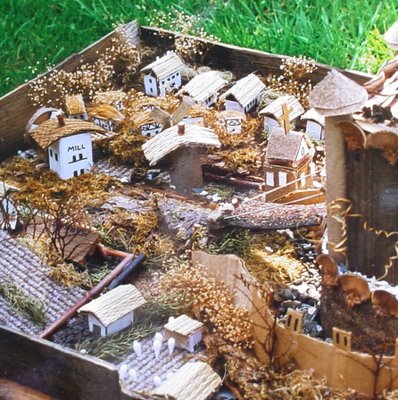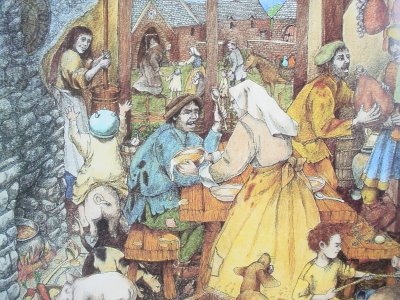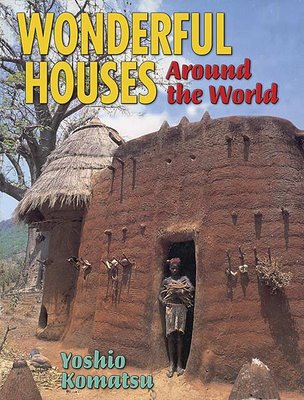 When my son Taraz was about 10, we worked on a medieval village, with a castle, for a extra-credit project for his class.
When my son Taraz was about 10, we worked on a medieval village, with a castle, for a extra-credit project for his class.He knew I loved constructing little dwellings, and so he gave me all the specifications - it had to have a castle with turrets, a moat with a drawbridge, fields with sheep, a church, mill, houses, and it had to be walled in, like a little city.
I got busy collecting cardboard, balsawood, sandpaper, old carpeting, and tons of organic stuff from the forest. Like pinecones, squash tendrils, dried flowers and seeds.
I got out my glue gun, and we worked (me primarily) for an entire day putting this village together. I used some references from the library as a guide, and we discussed the Middle Ages in Europe as we glued cardboard together, as the village was taking shape. The people, and their lives were very different from our own.
"House" by Albert Lorenz, covers the richness of the Middle Ages. A book I've often read to my grand-daughter, it says: The end of the Middle Ages in Europe was an exciting time to be alive. You can see it in the art of a painter like Pieter Brueghel, rich in color and action and passion. Here, in a peasant cottage in Flanders in the mid-sixteenth century, an extended family (including three generations and unmarried collateral relations) shares its space with as many useful animals as the household can afford.
 A midday meal is in progress. Filth and grunge rule, but it's a lusty and vibrant life for the healthy. The hearth with its bubbling stockpot serves both for cooking and for heating, and a good thing too, since there's no glass in the window to keep out the weather. "
A midday meal is in progress. Filth and grunge rule, but it's a lusty and vibrant life for the healthy. The hearth with its bubbling stockpot serves both for cooking and for heating, and a good thing too, since there's no glass in the window to keep out the weather. " I enjoyed details like this, when I was reading to my grand-daughter. She was learning about how other people lived long ago, and I was enjoying sharing books with her. "House" was one of my favorites.
In this book, the word "house" is used in the broadest possible way: a house is any structure built by human beings to live in for a time. This meaning embraces traditional houses but offers far more than that, seeking to convey some flavor of the amazing diversity of human culture across time and space, whether it is houses built for comfort, ones that afford the thinnest margin of survival in a hostile environment, or houses that segregate groups from the larger society.

Another enjoyable book is "Wonderful Houses Around the World", by Yoshio Komatsu. Just wonderful photos of adaptation and survival.
Of course, the Medieval Village Taraz and I created got highly rated at school, with an A+ for a grade, and it occupied our front porch for a long time, where the squirrels and mice nibbled at the acorns and seeds. Within a short time, our village was mashed to smithereens by cats sitting on the hayfields. The cotton swabs (sheep) were hauled away for mice nests, and the turrets toppled. I'm glad I remembered to take a photo before our village met its demise.